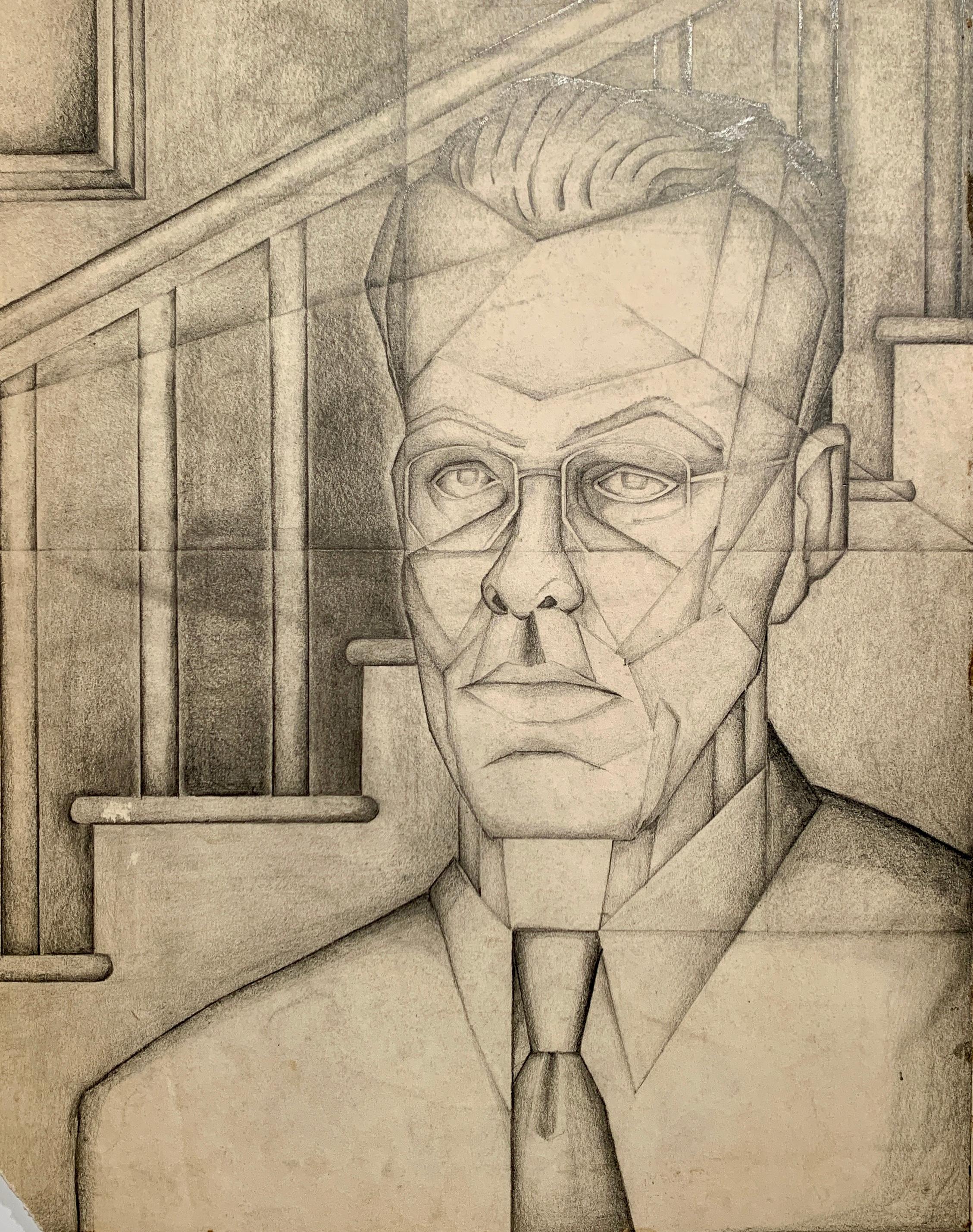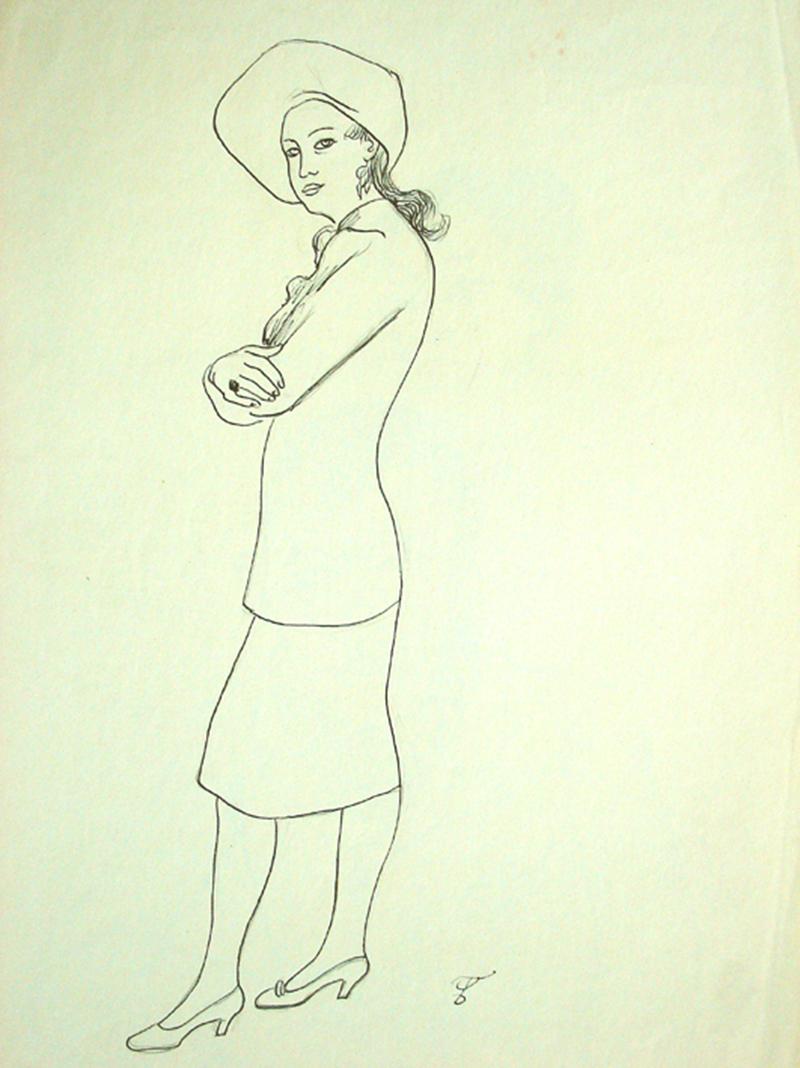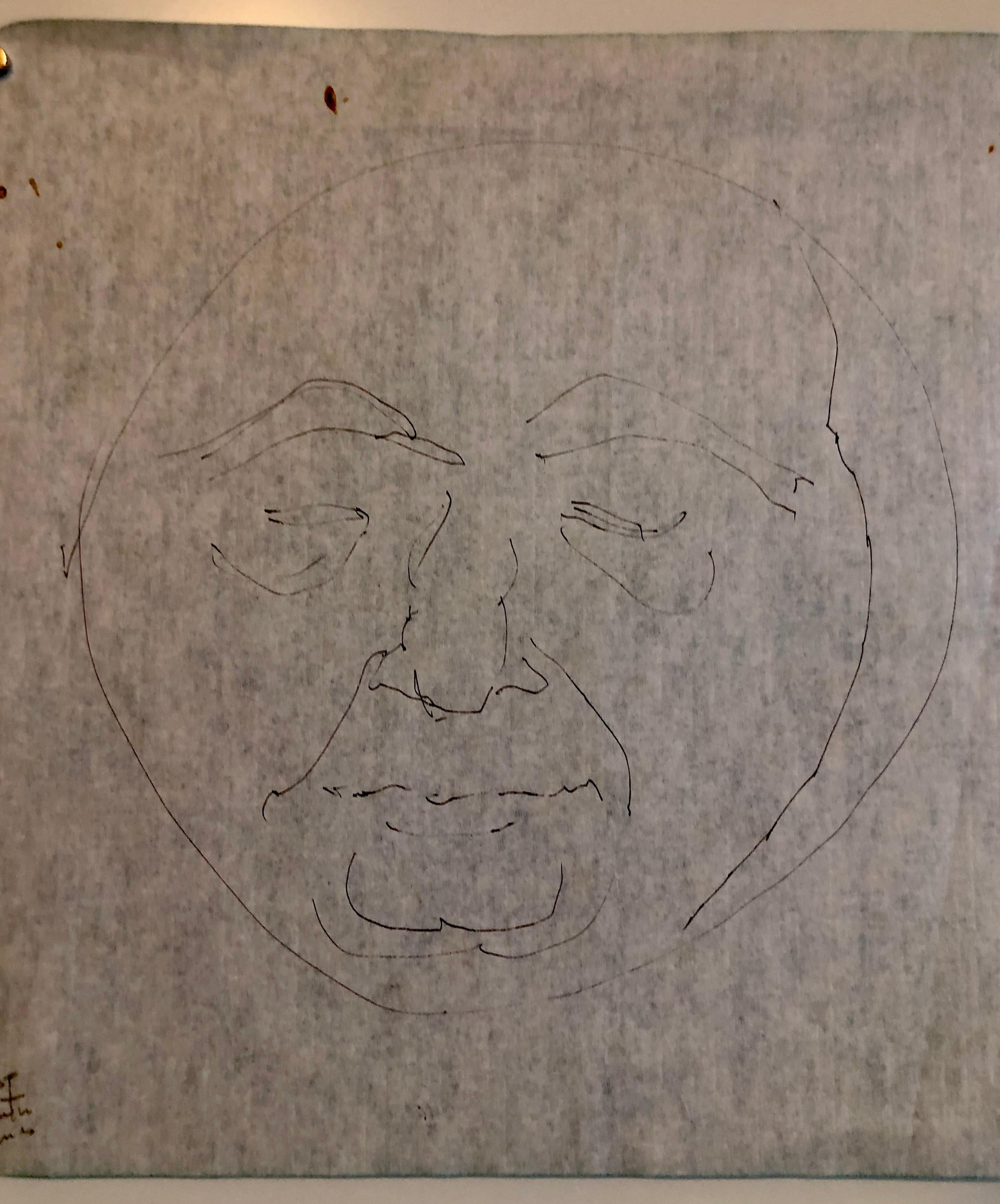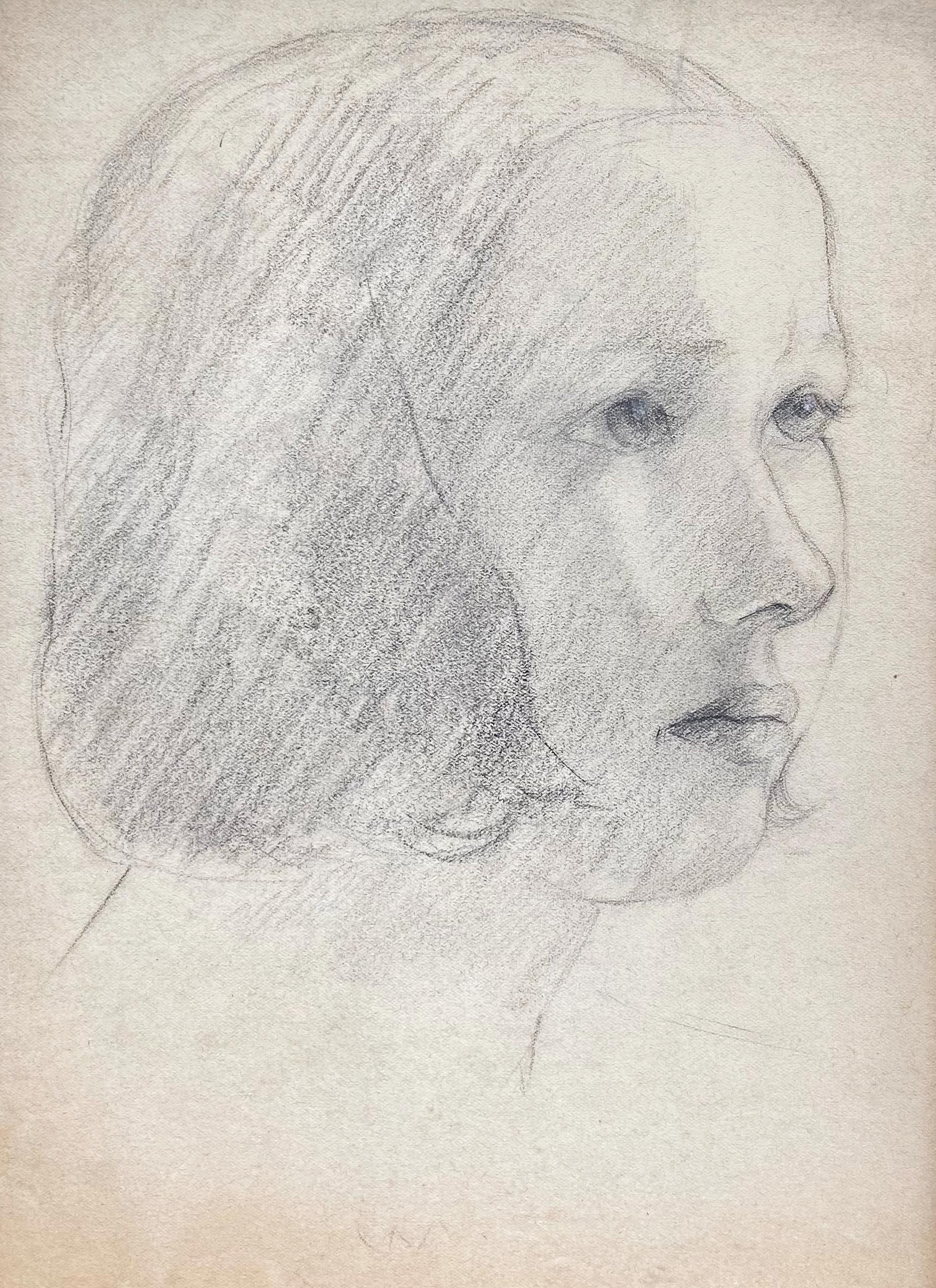Mino MaccariMale Profile - Drawing by Mino Maccari - 1950s1950s
1950s
About the Item
- Creator:Mino Maccari (1898 - 1989, Italian)
- Creation Year:1950s
- Dimensions:Height: 9.26 in (23.5 cm)Width: 6.74 in (17.1 cm)Depth: 0.04 in (1 mm)
- Medium:
- Movement & Style:
- Period:
- Framing:Framing Options Available
- Condition:Insurance may be requested by customers as additional service, contact us for more information.a.
- Gallery Location:Roma, IT
- Reference Number:
Mino Maccari
Popular painter, engraver and journalist Mino Maccari is known for his often controversial and explosive prints, drawings and paintings, and is considered to be one of the most important Italian satirical artists of the 20th century.
Born in 1898 in Siena, Maccari joined the Italian Army at age 19 to serve in World War I as an artillery officer. Afterward, he attended law school, graduating in 1920 and working as a lawyer until 1926.
While working as a lawyer, Maccari developed an interest in painting and engraving, moonlighting as an artist. Despite his lack of formal training, his works captured the attention of local critics, and he debuted with the Group Labronico, an organization of like-minded Italian artists that included painter Beppe Guzzi.
In 1924, publisher Angiolo Bencini contacted Maccari to oversee the printing operations of Il Selvaggio, a fascist magazine in which Maccari’s first satirical illustrations and engravings appeared. Until 1942, Maccari was editor-in-chief of the controversial magazine, which featured contributions from Futurist artists such as Ardengo Soffici, Carlo Carrà and others.
Throughout his career, Maccari participated in numerous notable exhibitions and shows throughout Italy and Europe. His figurative drawings and paintings, portraits and exotic nude works gained considerable acclaim from critics and collaborative artists.
In 1927, he participated in the "Second International Exhibition of Modern Engraving" and the "Third Exhibition of the Tuscan Union of Arts." The following year, Maccari exhibited at the Venice Biennale, where he would win the International Prize for engraving in 1948.
From the late 1940s to 1963, Maccari collaborated with the liberal magazine Il Mondo, contributing several satirical illustrations and engravings. By this time, he had become a well-established and respected artist in Italy and, in 1959, was named director of the Academy of Fine Arts in Rome.
In 1963, Maccari was recognized again for his works, winning the Antonio Feltrinelli Prize for painting. That same year, he became president of the San Luca Academy.
Throughout the 1970s, Maccari continued painting and drawing, creating provocative works such as Dominatrix Woman, a bold work in watercolor and pastel, the diminutive pen drawing Trampled and his erotic charcoal and watercolor drawing Mata Hari.
Even after Maccari’s death in 1989, his works continue to be a talking point among avid modern art collectors.
Find original Mino Maccari drawings and watercolor paintings, prints and other art on 1stDibs.
- ShippingRetrieving quote...Ships From: Grasse, France
- Return PolicyA return for this item may be initiated within 14 days of delivery.
- Nude of Woman - Original Drawing by Alexandre Bida - Mid 19th CenturyLocated in Roma, ITNude of Woman is an Original pencil and white lead Drawing realized by Alexandre Bida (1823-1895). The artwork in good condition on a clue paper, inclu...Category
Mid-19th Century Modern Figurative Drawings and Watercolors
MaterialsPencil
- Portrait of Pierre-Jean de Béranger - Original Drawing - Early 19th CenturyLocated in Roma, ITPortrait of Pierre-Jean de Béranger is an original drawing in Pencil realized in the Early 19th Century. Good conditions. The artwork is depicted through soft strokes in a well-bal...Category
Early 20th Century Modern Figurative Drawings and Watercolors
MaterialsPencil
- The Escaping - Drawing by Mino Maccari - Mid-20th CenturyBy Mino MaccariLocated in Roma, ITThe Escaping is an Original Drawing on creamy-colored paper realized by Mino Maccari in the mid-20th century. Hand-signed by the artist on the lower. Good conditions with some smal...Category
Mid-20th Century Modern Figurative Drawings and Watercolors
MaterialsCarbon Pencil
- The Profile - Drawing by Mino Maccari - Mid-20th CenturyBy Mino MaccariLocated in Roma, ITThe Profile is an Original Drawing in pencil and carbon on creamy-colored paper realized by Mino Maccari in the mid-20th century. Hand-signed by the artist on the lower. Good condi...Category
Mid-20th Century Modern Figurative Drawings and Watercolors
MaterialsCarbon Pencil
- Portraits - Original Drawing by Alfred Grevin - Late 19th CenturyBy Alfred GrevinLocated in Roma, ITPortraits is an original drawing in Pencil and watercolor realized by Alfred Grévin in the Late-19 Century. Applied on a Passeprtout:36 x 26 cm. With the stamp of atelier "Grevin" ...Category
Late 19th Century Modern Figurative Drawings and Watercolors
MaterialsPencil
- The Execution - Drawing by Mino Maccari - Mid-20th CenturyBy Mino MaccariLocated in Roma, ITThe Execution is an Original Drawing in pastel and pencil on creamy-colored paper realized by Mino Maccari in the mid-20th century. Hand-signed by the artist on the lower. Good con...Category
Mid-20th Century Modern Figurative Drawings and Watercolors
MaterialsPastel, Pencil
- 1940s Charcoal and Pencil Portrait of a ManLocated in Arp, TXArtist Unknown "Tie and Glasses" c. 1940s Charcoal and pencil on paper 13.5"x17" image 15.5"x19" paper unframed $250 Unsigned *Listed price reflects custom framing selected by seller...Category
1940s Modern Portrait Drawings and Watercolors
MaterialsPaper, Charcoal, Carbon Pencil
- Dame mit HutBy August Wilhelm DresslerLocated in Wien, 9August Dressler is one of the painters of the New Objectivity. He is one of the lesser-known artists of the Weimar era, but he too, like his famous contemporaries Georg Grosz, John H...Category
20th Century Modern Figurative Drawings and Watercolors
MaterialsPencil, Paper
- Boston Abstract Expressionist Hyman Bloom Original Pencil Drawing Martin SumersBy Hyman BloomLocated in Surfside, FLThis is a unique artwork. This is an original Hyman Bloom drawing of fellow artist and his very good friend Martin Sumers.I believe this was drawn at the “variations of a theme” at Sumers gallery in NYC. The last two photos show a poster and a card from their shows. it is not included in this listing, it is just for provenance. Provenance: Acquired from the Sumers estate collection. Hyman Bloom (March 29, 1913 – August 26, 2009) was a Latvian-born American painter. His work was influenced by his Jewish heritage and Eastern religions as well as by artists including Altdorfer, Grünewald, Caravaggio, Rembrandt, Blake, Bresdin, James Ensor and Chaim Soutine. He first came to prominence when his work was included in the 1942 Museum of Modern Art exhibition "Americans 1942 -- 18 Artists from 9 States". MoMA purchased 2 paintings from the exhibition and Time magazine singled him out as a "striking discovery" in their exhibition review. His work was selected for both the 1948 and 1950 Venice Biennale exhibitions and his 1954 retrospective traveled from Boston's Institute of Contemporary Art to the Albright Gallery and the de Young Museum before closing out at The Whitney Museum of American Art in 1955. In a 1954 interview with Yale art professor Bernard Chaet, Willem de Kooning indicated that he and Jackson Pollock both considered Bloom to be “America’s first abstract expressionist”, a label that Bloom would disavow. Starting in the mid 1950s his work began to shift more towards works on paper and he exclusively focused on drawing throughout the 1960s, returning to painting in 1971. He continued both drawing and painting until his death in 2009 at the age of 9 Hyman Bloom (né Melamed) was born into an orthodox Jewish family in the tiny Jewish village of Brunavišķi in what is now Latvia, then part of the Russian Empire At a young age Bloom planned to become a rabbi, but his family could not find a suitable teacher. In the eighth grade he received a scholarship to a program for gifted high school students at the Museum of Fine Arts. He attended the Boston High School of Commerce, which was near the museum. He also took art classes at the West End Community Center, a settlement house. The classes were taught by Harold Zimmerman, a student at the School of the Museum of Fine Arts, who also taught the young Jack Levine at another settlement house in Roxbury. When Bloom was fifteen, he and Levine began studying with a well-known Harvard art professor, Denman Ross, who rented a studio for the purpose and paid the boys a weekly stipend to enable them to continue their studies rather than take jobs to support their families. He took Bloom and Levine on a field trip to the Museum of Modern Art in New York, where Bloom was impressed by the work of Rouault and Soutine and began experimenting with their expressive painting styles. In the 1930s Bloom worked sporadically for the Public Works of Art Project and the Federal Art Project (WPA), He shared a studio in the South End with Levine and another artist, Betty Chase. It was during this period that he developed a lifelong interest in Eastern philosophy and music, and in Theosophy. He first received national attention in 1942 when thirteen of his paintings were included in the Museum of Modern Art (MoMA) exhibition Americans 1942: 18 Artists from 9 States, curated by Dorothy Miller. MoMA purchased two of his paintings from that exhibition, and he was featured in Time magazine. The titles of his paintings in the exhibition reflect some of his recurring themes. Two were titled The Synagogue, another, Jew with the Torah; Bloom was actually criticized by one reviewer for including "stereotypical" Jewish images. He also had two paintings titled The Christmas Tree, and another titled The Chandelier, both subjects he returned to repeatedly. Another, Skeleton (c. 1936), was followed by a series of cadaver paintings in the forties, and The Fish (c. 1936) was one of many paintings and drawings of fish he created over the course of his career. Bloom was associated at first with the growing Abstract Expressionist movement. Willem de Kooning and Jackson Pollock, who first saw Bloom's work at the MoMA exhibition, considered Bloom "the first Abstract Expressionist artist in America." In 1950 he was chosen, along with the likes of de Kooning, Pollock, and Arshile Gorky, to represent the United States at the Venice Biennale. That same year Elaine de Kooning wrote about Bloom in ARTnews, noting that in paintings such as The Harpies, his work approached total abstraction: "the whole impact is carried in the boiling action of the pigment". In 1951 Thomas B. Hess reproduced Bloom's Archaeological Treasure in his first book, Abstract Painting: Background and American Phase, along with works by Picasso, Pollock, and others. Both de Kooning and Hess remarked on Bloom's expressive paint handling, a key characteristic of Abstract Expressionist painting. As abstract expressionism dominated the American art world, Bloom became disenchanted with it, calling it "emotional catharsis, with no intellectual basis." In addition, instead of moving to New York to pursue his career, he opted to stay in Boston. As a result he fell out of favor with critics and never achieved the kind of fame that Pollock and others did. He disliked self-promotion and never placed much value on critical acclaim. Many of Bloom's paintings feature rabbis, usually holding the Torah. According to Bloom, his intentions were more artistic than religious. He began questioning his Jewish faith early in life, and painted rabbis, he claimed, because that was what he knew. Over the course of his career he produced dozens of paintings of rabbis...Category
20th Century Modern Figurative Drawings and Watercolors
MaterialsPaper, Pencil
- The New Haircut, 20th Century portrait of a Young Girl, drawingLocated in London, GBGraphite on paper Image size: 11 ¾ x 8 ½ inches (30 x 21.5 cm) Original frame This superbly-drawn portrait highlights the artist’s undeniable skill as a portrait artist, particularl...Category
20th Century Modern Portrait Drawings and Watercolors
MaterialsGraphite, Paper
- Portrait of a Woman Sitting in ProfileBy James StroudleyLocated in London, GBGraphite on paper Image size: 10 1/2 x 14 1/4 inches (26.5 x 36 cm) Mounted A fine pencil drawing and a stunning example of a 1930s Art Deco portrait.Category
1930s Modern Portrait Drawings and Watercolors
MaterialsGraphite
- Portrait of Alfred Hardiman, Graphite Sketch, Signed and Dated 1925Located in London, GBGraphite on paper, signed and dated Image size: 18 x 12 1/2 inches (46 x 32 cm) Mounted and framed The sitter for this portrait, Alfred Hardiman, was an English sculptor. Hardiman and Lyon were friends and met when they both attended the British School at Rome in the early 1920s. Hardiman won a London County Council Scholarship to the Royal College of Art in 1912, and three years later joined the Royal Academy School. After a period as an engineer's draughtsman in the Royal Flying Corps during the First World War, Hardiman resumed his studies and in 1920 was awarded the British Prix de Rome scholarship, spending two years at the British School at Rome. There he developed his style, a blend of naturalism and classicism influenced by Roman and Etruscan art and early fifth century Greek sculpture. Hardiman's best-known (but also most controversial) work is the Earl Haig Memorial on Whitehall in London. More universally admired are the heraldic lions flanking the main entrance to the City Hall, Norwich, a work which fully epitomises his style. He was appointed consultant sculptor to the building, having worked with one of the architects, Stephen Rowland Pierce, on the Haig Memorial. Hardiman also carved three large stone figures for the outside of the council chamber, and worked with other sculptors on the project including James Woodford and Eric Aumonier. Hardiman was elected Associate of the Royal Academy in 1936 and a full Academician in 1944. He became a fellow of the Royal Society of British Sculptors in 1938 and the following year received their silver medal for his statue of Haig. In 1946 he won a gold medal for his bronze fountain figure for the New Council House, College Green, Bristol, which however was never erected. In 1918 he married Violet, daughter of Herbert Clifton White, of London, and had two daughters. He died at Stoke Poges on 17th April 1949. Robert Lyon...Category
1920s Modern Portrait Drawings and Watercolors
MaterialsPaper, Graphite





